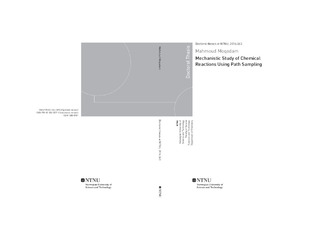| dc.contributor.advisor | van Erp, Titus S. | |
| dc.contributor.advisor | Åstrand, Olof | |
| dc.contributor.author | Moqadam, Mahmoud | |
| dc.date.accessioned | 2017-03-03T15:11:54Z | |
| dc.date.available | 2017-03-03T15:11:54Z | |
| dc.date.issued | 2016 | |
| dc.identifier.isbn | 978-82-326-2071-5 | |
| dc.identifier.issn | 1503-8181 | |
| dc.identifier.uri | http://hdl.handle.net/11250/2432969 | |
| dc.description.abstract | Molecular simulations are the ideal tool to obtain detailed information at the molecular scale which is often invisible to experiments. However, we are still far from a situation in which industries and pharmaceutical laboratories effectively design new materials and medicines based on molecular modeling. Present simulation techniques such as standard molecular dynamics can not reach time- and length-scales required to study complex chemical and biological processes, or they are based on inaccurate and oversimplified models which make them unreliable. Several methods have been proposed over the last decades in order to overcome these problems. Many of those methods are able to provide thermodynamic properties much faster than plain molecular dynamics does, but they force the system in an unnatural way and, therefore, information about the unbiased dynamics is lost. The Transition Path Sampling (TPS) pioneered another approach showing how one can harvest paths (short molecular trajectories) via a statistically sound Monte Carlo approach. Based on this principle TPS also provided an algorithm for the determination of rate constants. Several aspects of this original algorithm were improved by the Transition Interface Sampling (TIS) method. Another variation of TIS, Replica Exchange TIS (RETIS), improved the algorithmic efficiency even further. TIS and RETIS divide the phase space in subregions using interfaces and gather a collection of true dynamical unbiased trajectories connecting the reactant and product states without a priori assumption of the reaction coordinate. From these ensembles of pathways, reaction mechanisms can be extracted and rate constants can be computed.
In this work, for the first time, we use a combination of the RETIS simulations with Ab initio molecular dynamics to study two realistic and challenging reactions. These reactions are autoionization of water and silicate oligomerization reactions. Although these reactions have previously been studied experimentally and/or theoretically, the exact mechanisms of reactions and rate constants are still under discussion. The autodissociation of a water molecule in pure water or an aqueous solution is a fundamental event in acid-base chemistry and is an extremely rare event on the femtosecond time scale of molecular motions. Silicate oligomerization is also a fundamental reaction that is at the basis of sol-gel chemistry and the formation of nanoporous silicate materials. RETIS provides a quantitative and deep qualitative analysis of these fundamental processes. In addition to the RETIS simulations, we have tested a ReaxFF forcefield for the silicate dimerization reactions and have examined this process with Ab initio molecular dynamics simulations using the more conventional thermodynamic integration methods. With these molecular dynamics simulations, we can study both dynamics properties and time dependent kinetic phenomena. Finally, we introduce an approach to analyze collective variables regarding their predictive power for a reaction. The method is based on already available path sampling data produced by, for instance, transition interface sampling or forward flux sampling. | nb_NO |
| dc.language.iso | eng | nb_NO |
| dc.publisher | NTNU | nb_NO |
| dc.relation.ispartofseries | Doctoral theses at NTNU;2016:363 | |
| dc.relation.haspart | Paper 1:
Moqadam, Mahmoud; Riccardi, Enrico; Trinh, Thuat; Åstrand, Per-Olof; van Erp, Titus Sebastiaan.
A test on reactive force fields for the study of silica dimerization reactions. Journal of Chemical Physics 2015 ;Volum 143:184113.(18) https://doi.org/10.1063/1.4935179 | |
| dc.relation.haspart | Paper 2:
Moqadam, Mahmoud; Riccardi, Enrico; Trinh, Thuat; Lervik, Anders; van Erp, Titus Sebastiaan.
Rare event simulations reveal subtle key steps in aqueous silicate condensation.
- Published in Physical Chemistry, Chemical Physics - PCCP 2017 ;Volum 19.(20) s. 13361-13371
https://doi,org/10.1039/C7CP01268C | |
| dc.relation.haspart | Paper 3:
van Erp, Titus Sebastiaan; Moqadam, Mahmoud; Riccardi, Enrico; Lervik, Anders.
Analyzing Complex Reaction Mechanisms Using Path Sampling. Journal of Chemical Theory and Computation 2016 ;Volum 12.(11) s. 5398-5410
https://doi.org/10.1021/acs.jctc.6b00642 | |
| dc.relation.haspart | Paper 4:
van Erp, Titus Sebastiaan; Lervik, Anders; Moqadam, Mahmoud; Riccardi, Enrico.
Concerted and stepwise autoionization of water. ICCMSE 2017 | |
| dc.title | Mechanistic Study of Chemical Reactions Using Path Sampling | nb_NO |
| dc.type | Doctoral thesis | nb_NO |
| dc.subject.nsi | VDP::Mathematics and natural science: 400::Chemistry: 440 | nb_NO |
